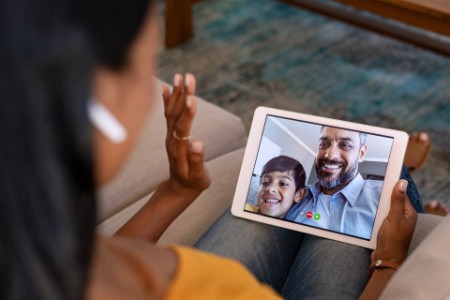
More engagement, more anxiety? COVID-19’s impact on the digital home
COVID-19 continues to drive a surge in digital home activities
Lockdown measures have driven households to engage with digital products and services for the first time
It is evident that the lockdown measures as a result of COVID-19 have stimulated the adoption of digital products and services, often for the first time by some households. Video calling leads the way — with 36% of consumers using it for the first time since the COVID-19 crisis began, a figure that has grown from 18% at the end of March. Limited access to the high street has also been responsible for a rise in online shopping from 9% to 15%.
As well as trying out new products and services, we’re also doing more of what we did before. Internet browsing has increased alongside making more group video calls, using social media more often and watching more streamed TV.
Adoption of video calling
36%have tried video calling for the first time since the lockdown

More engagement, more anxiety? COVID-19’s impact on the digital home
More receptive to new technology, willing to spend more than before
Increased adoption and usage of specific products and services reflect greater levels of engagement with technology in general
It is vital to act now to translate this higher engagement, into higher usage — and spending — once the immediate crisis recedes. Twenty-one percent of consumers are more engaged with the latest technology and gadgets as a result of the crisis. This is partnered by a reduction in fears over too much screen time, with the level of consumers actively seeking time away from their smart phones dropping from 49% last year, to 29% during the crisis.
And the spending outlook is broadly positive. Although most households see their monthly spending staying the same, more households predict their monthly spend on connectivity and content increasing rather than decreasing after the crisis.
Household monthly spending intentions beyond COVID-19

More engagement, more anxiety? COVID-19’s impact on the digital home
Increased reliance on digital is adding to household anxieties
Despite higher levels of engagement and a resilient spending outlook, the pandemic is breeding uncertainties over data privacy and security
Online disclosure and exposure are clear concerns: consumers are more worried than before about transmitting personal data or encountering harmful content online, for example.
The popularity of smart home devices has led to concerns by over 50% of respondents about what personal information is captured and shared. With the increase in adoption of video calling, consumers are concerned about potential hacking. Their anxiety is coupled by a lack of confidence that businesses are ill-equipped to help, with 26% concerned organisations are not able to keep their personal data safe as a result of the pandemic.
Smart home device data concerns
52%are concerned about smart devices capturing personal data

More engagement, more anxiety? COVID-19’s impact on the digital home
Home working is creating its own set of well-being challenges
The rise in home working is another clear result of the crisis, with apps and software playing a vital role.
Physical and emotional challenges have been identified in the survey as a consequence of the lockdown. 32% of all households surveyed have increased the amount of home working via online collaboration tools since lockdown measures were put in place. Eighty percent of households believe that the crisis has shown that office jobs can be done just as effectively from home, underlining the sense that this transition is much more than a passing reaction to lockdown measures.
The survey indicates this shift is also now creating well-being challenges. Thirty-four percent of respondents believe household members are struggling to maintain work-life balance. Twenty-five percent cannot work effectively due to space constraints. The research also shows that our reliance on the robustness of connectivity is not holding its own, with 26% saying inconsistent broadband performance is making it difficult to work from home.
Work life balance concerns
34%are struggling to maintain work life balance
Inconsistency of broadband performance
26%say inconsistent broadband performance makes it difficult to work from home

More engagement, more anxiety? COVID-19’s impact on the digital home
Not all digital homes are the same
The survey responses also reveal a divergence of attitudes according to age, size of household and location
The step-change in digital engagement is most pronounced among younger respondents: 36% of 18–24 year olds believe the crisis has made them more alert to the connectivity and content they purchase, compared with 27% of all respondents. Yet this also means they are more likely to consider long-term loyalty during the crisis: 45% of 25–34 year olds say the way their broadband provider performs now will have an impact on whether they stay loyal, compared with 36% of all respondents.
Meanwhile, larger households are relatively more interested in smart home technology that can bring new forms of convenience. Twenty-two percent of homes with two children say the crisis has made them realise the value of smart utilities, compared with 15% of all respondents. They also worry more about online safety — 43% of two children households worry about harmful content, compared with 24% of all respondents.
Harmful content concerns
43%of two children households worry about harmful content, compared to 24% of all respondents
Summary
TMT providers should act now to ensure their customers adapt as smoothly as possible to a fast-changing world where previous norms no longer apply. There are three key considerations for TMT providers in the months to come:
- Focus on converting higher engagement during lockdown into long-term usage and spending growth
- Address digital anxieties to come closer to your customers
- Sensitise your value proposition to the needs of different households
For details of each, please refer to the detailed EY report (PDF 452KB).


